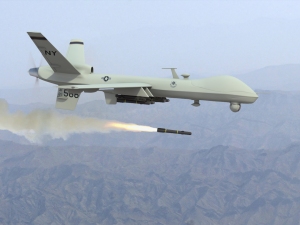What are Drones?
Unmanned aerial vehicles (UAVS), also known as drones, are aircraft either controlled by ‘pilots’ from the ground or increasingly, autonomously following a pre-programmed mission. (While there are dozens of different types of drones, they basically fall into two categories: those that are used for reconnaissance and surveillance purposes and those that are armed with missiles and bombs. The
use of drones has grown quickly in recent years because unlike manned aircraft they can stay aloft for many hours (Zephyr a British drone under development has just broken the world record by flying for over 82 hours nonstop); they are much cheaper than military aircraft and they are flown remotely so there is no danger to the flight crew.
While the British and US Reaper and Predator drones are physically in Afghanistan and Iraq, control is via satellite from Nellis and Creech USAF base outside Las Vegas, Nevada. Ground crews launch drones from the conflict zone, then operation is handed over to controllers at video screens in specially designed trailers in the Nevada desert. One person ‘flies’ the drone, another operates and monitors the cameras and sensors, while a third person is in contact with the “customers”, ground troops and commanders in the war zone. While armed drones were first used in the Balkans war, their use has dramatically escalated in Afghanistan, Iraq and in the CIA’s undeclared war in Pakistan.
The Only Game in Town
The US has two separate ‘squadron’ of armed drones – one run by the US Air Force and one run by the CIA. Using drones, the USAF Air Force has increased the number of combat air patrols it can fly by 600 percent over the past six years; indeed at any time there are at least 36 American armed UAVS over Afghanistan and Iraq. It plans to increase this number to 50 by 2011. CIA Director Leon Panetta has recently said that drones are “the only game in town.” The CIA have been using drones in Pakistan and other countries to assassinate “terrorist leaders.” While this programme was initiated by the Bush Administration, it has increased under Obama and there have been 41 known drone strikes in Pakistan since Obama became President. Analysis by an American think tank The Brookings Institution on drone attacks in Pakistan has shown that for every militant leader killed, 10 civilians also have died.
Drones UK
The UK has several different types of armed and surveillance drones in Iraq and Afghanistan and others in the production or development stage. The UK began using armed drones in Afghanistan in Oct 2007 after purchasing three Reapers from General Atomics in 2007 at a cost of £6m each. The MoD confirmed in June 2008 that a British Reaper UAV had fired its weapons for the first time, but refused to give any details. In March 2009, the Daily Telegraph reported that British drones had been used ten times in armed strikes.
Watchkeeper
As well as armed drones, the UK has several types of surveillance drones, most notably Watchkeeper, a drone jointly produced by Israeli company Ebit and Thales UK. The UK is purchasing 54 Watchkeeper drones and ground stations at a cost of £860m. The first ten will be built in Israel and then production will transfer to a specially built facility in Leicester. Testing is taking place at Aberporth in Wales and Watchkeeper is due to enter service in 2010. There have recently been reports that Watchkeeper may be armed in the future.
Serious Concern
Thes UN’s Special Rapporteur on extrajudicial, summary or arbitrary executions, Philip Alston, has said that the use of drones is not combat as much as ‘targeted killing’. He has repeatedly tried to get the US to explain how they justifies the use of drones to target and kill individuals under international law. The US has so far refused to do so. In a report to the UN he has said the US government (and by implication the UK government) “should specify the bases for decisions to kill rather than capture particular individuals …. and should make public the number of civilians killed as a result of drone attacks, and the measures in place to prevent such casualties”.
A further question is the extent to which operators become trigger happy with remote controlled armaments, situated as they are in complete safety, distant from the conflict zone. Keith Shurtleff, an army chaplain and ethics instructor at Fort Jackson, South Carolina worries “that as war becomes safer and easier, as soldiers are removed from the horrors of war and see the enemy not as humans but as blips on a screen, there is very real danger of losing the deterrent that such horrors provide.”
Increased Surveillance
Military drone manufacturers are looking for civilian uses for remote sensing drones to expand their markets and this includes the use of drones for domestic surveillance. Drones will no doubt make possible the dramatic expansion of the surveillance state. With the convergence of other technologies it may even make possible machine recognition of faces, behaviours, and the monitoring of individual conversations. The sky, so to speak, is the limit.
